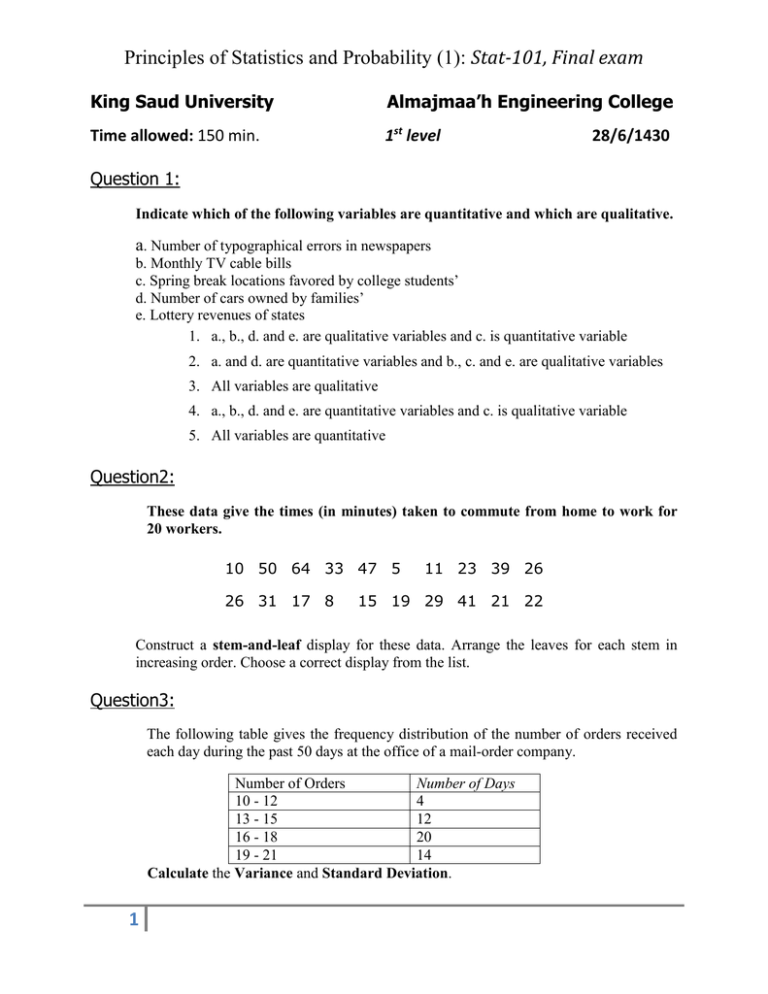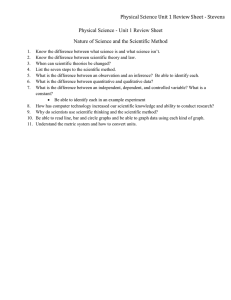test1-final-stat-30
advertisement

Principles of Statistics and Probability (1): Stat-101, Final exam King Saud University Almajmaa’h Engineering College Time allowed: 150 min. 1st level 28/6/1430 Question 1: Indicate which of the following variables are quantitative and which are qualitative. a. Number of typographical errors in newspapers b. Monthly TV cable bills c. Spring break locations favored by college students’ d. Number of cars owned by families’ e. Lottery revenues of states 1. a., b., d. and e. are qualitative variables and c. is quantitative variable 2. a. and d. are quantitative variables and b., c. and e. are qualitative variables 3. All variables are qualitative 4. a., b., d. and e. are quantitative variables and c. is qualitative variable 5. All variables are quantitative Question2: These data give the times (in minutes) taken to commute from home to work for 20 workers. 10 50 64 33 47 5 26 31 17 8 11 23 39 26 15 19 29 41 21 22 Construct a stem-and-leaf display for these data. Arrange the leaves for each stem in increasing order. Choose a correct display from the list. Question3: The following table gives the frequency distribution of the number of orders received each day during the past 50 days at the office of a mail-order company. Number of Orders Number of Days 10 - 12 4 13 - 15 12 16 - 18 20 19 - 21 14 Calculate the Variance and Standard Deviation. 1 Principles of Statistics and Probability (1): Stat-101, Final exam Question4: In a heath survey, in U.S. adults were asked to rate their health. The table below summarizes their responses. Choose the correct pie chart for this percentage distribution. State of health Poor Fair Good Very good Excellent a) Figure 1. Percentage of Response 2.5 11.9 32.3 36.2 17.1 Figure 1. Figure 3. Figure 2. Figure 4. b) Figure 2. c) Figure 3 d) Figure 4 Question5: The following data give the speeds of 13 cars, measured by radar, travelling on the highway in mile/hr a) Find the values of the three quartiles and the interquartile range. b) Calculate the (approximate) value of the 35th percentile. c) Find the percentile rank of 71 2 Principles of Statistics and Probability (1): Stat-101, Final exam Question 6: Prepare a box-and-whisker plot for the following data: 36 54 28 52 41 59 47 61 24 55 63 73 32 25 35 49 31 22 61 42 58 65 98 34 Does this data set contain any outliers? Question 7: a) Define the following terms: Probability - Outcome - Simple event b) Complete: An event that is certain to occur has a probability equal to ...... and is called a ............... event. An event that cannot occur has ............ probability; such an event is called .................event. Question 8: List the simple events for each of the following statistical experiments in a sample space S. a. Three tosses of a coin b. One roll of a die and one toss of a coin Question 9: Answer only 2 of the following: a. Draw the Venn and tree diagrams for the experiment of tossing a coin twice. b. Find the probability of obtaining an even number in one roll of a die. c. A random sample of 3000 adults showed that 1540 of them have shopped at least once on the Internet. What is the (approximate) probability that a randomly selected adult has shopped on the Internet? 3 Principles of Statistics and Probability (1): Stat-101, Final exam Question 10: In a group of people, some are in favour of chemical engineering and others are against. Two persons are selected at random from this group and asked whether they are in favour of or against chemical engineering. How many distinct outcomes are possible? List all the outcomes included in each of the following events and mention whether they are simple or compound events. a. Both persons are against chemical engineering. b. At most one person is in favor of chemical engineering. c. Exactly one person is against chemical engineering. Question 11: a) Which of the following values cannot be probabilities of events and why? 1/6 .87 −.95 1.26 4/3 0.0 −4/7 1.0 b) The coach of a college football team thinks there is a .75 probability that the team will win the national championship this year. Is this a case of classical, relative frequency, or subjective probability? Explain why. Question 12: A multiple-choice question on a test has four answers. If Ahmed chooses one answer based on “pure guess,” what is the probability that his answer is a. Correct? b. Wrong? Do these two probabilities add up to 1.0? If yes, why? Best wishes… Dr. SaMeH Ahmed 4



